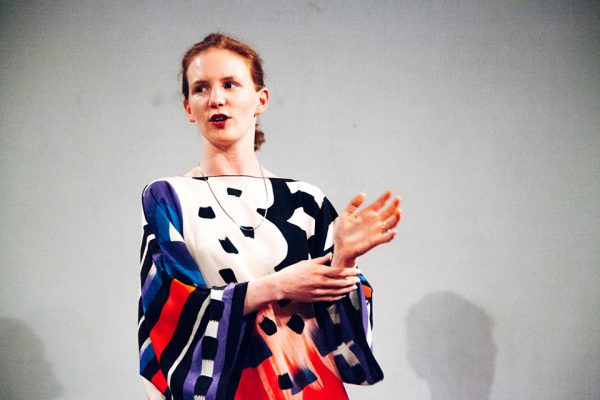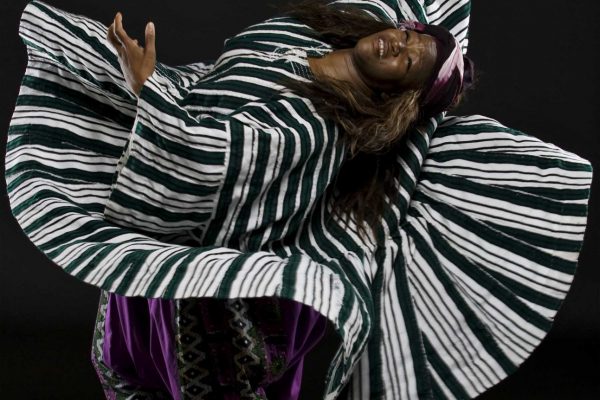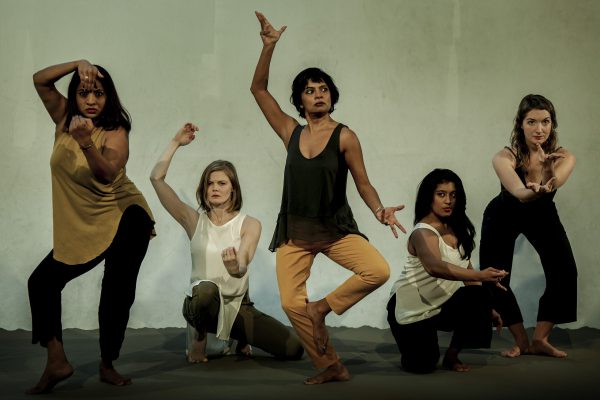That a dance company manages to reach a twentieth anniversary is no mean feat, given the difficulties that the performing arts face today. That the company in question has arisen out of an ethnic immigrant milieu, makes those twenty years all the sweeter.
COBA – Collective of Black Artists began life in 1993 primarily to fill a gap. In the Toronto of the day, choreographic voices from the black diaspora were almost invisible. COBA’s co-founders – Junia Mason, Kim McNeilly (now Mosa Neshama), Charmaine Headley and Eddison B. Lindsay (now BaKari I. Lindsay) – joined together to present the black experience in dance. In other words – choreography by black dancesmiths, performed by black dancers.
Early in the game, the company’s main focus was on the careful re-creation of traditional dances and rituals (“in their purest form” as Évoque’s program note puts it) from the founders’ Afro-Caribbean heritage. The very first time I saw COBA was at the Winchester Street Theatre in 1995. The program consisted of Lindsay’s full-length Dance Belé, a “folk theatre” of indigenous dances arising out of slavery in his native Trinidad and Tobago. One intriguing section, as I recall, described how the slaves had borrowed the minuet from their masters and Africanized it. I remember being tremendously impressed by the live drumming and chanting accompaniment and by the fact that Lindsay had actually made the colourful authentic costumes himself.
Fast forward to 2003 and the tenth anniversary year. By this point, COBA had progressed from the Winchester Street Theatre to the larger Betty Oliphant Theatre and, finally, to the larger still Premiere (now Fleck) Dance Theatre. The repertoire had expanded to include works representing both COBA’s Afro-Caribbean roots and the present-day concerns of the city’s black community. COBA was a reflection of the black experience, past and present, through traditional and contemporary dance.
I pointed out in my Globe and Mail review at the time (D’ is We, February 27, 2003) how the company was gaining in professional savvy. The dance ensemble was better disciplined, and there was a genuine visual slickness to the product. COBA had earned its place in the mainstream with concerts that had a broad appeal. The balance of subject matter in the 2003 show was what had become, and remains, quintessential COBA – two dances anchored in the African motherland, one in the Caribbean diaspora and one reflecting urban black Toronto. The latter was an ambitious melding of African/contemporary fusion. Lindsay’s Griot’s Jive – Still (a remount from the previous year) transformed the West African oral history/storyteller tradition (griot) into a modern-day statement against gun violence. In this case, the storytellers, via film clips, were the mothers of dead children. The dance portion began in a nightclub and ended with a ghostly ritual for slain youth.
Which brings us to the present day. A big cause for celebration is the fact that COBA was selected to be one of the tenants in the Daniels Spectrum, the new arts and culture centre in the newly redeveloped Regent Park area of downtown Toronto. COBA was clearly chosen based on what the company could bring to the community at large, particularly open drum and dance classes for both teens and adults, a children’s dance and drum program and workshops for seniors. Perhaps most importantly, COBA represents a reflection of the black aesthetic that could, hopefully, attract both an audience and participants from among the black residents of the Regent Park neighbourhood.
COBA’s twentieth anniversary concert, Évoque: passions deep within took place in its new home, the 300-seat Ada Slaight Hall. The performance area is generous and there are steeply banked bleachers that provide very good sightlines. Some of COBA’s dance works involve large numbers of people so the extra depth comes in handy.
There is a given about a COBA concert – a fact of life that COBA must accept – the drumming and dancing pieces are, by far and away, the most popular on the program. It would be very easy for Lindsay and Headley to give over to the tried and true. Instead, their programs almost always include contemporary works that are generally more challenging for the audience. Another given is that, while COBA has a professional training school, it does not maintain a permanent company. Thus, the ensemble is not going to have the fine finish of a corps de ballet who work together throughout the year. Yet COBA’s production values are always first rate. Arun Srinivasan lit the show with his usual deft hand, and yes, Lindsay is still designing and constructing the costumes.
Lindsay has a track record for choreographing excellent solos on himself. Ancestral Calling (2012) is a case in point, and was the strongest work on the anniversary program. The premise of the piece involves a transformation in which a projected cityscape turns into a dappled forest. An urban street guy in track pants and hoodie, lying on the floor (Is he homeless? A drunk?) turns into a noble tribal warrior, garbed in a loincloth, face painted in ritual white. (The hoodie had been hiding the makeup.) The choreography is designed to present a manly man in the prime of life.
Lindsay is blessed with a compact, well-muscled, supple body. He is a superb dancer, executing controlled knee raises, side lunges, deep pliés and stomach thrusts with the ease of a much younger man. The soundtrack is by the Trevor Watts Drum Orchestra, a potent mix of heavy, rhythmic African percussion and a soulful jazz saxophone. The apex of the work occurs when this warrior gives himself over to the rhythm of the music, swaying within its embrace. The tone of the work, however, is melancholy, as is the music. Ultimately, it is about loss.
Two premieres were the problem children of the evening.
Lindsay’s Doption draws on two traditions. One is African spiritualism. The other is the modern-day Shouter Baptist movement. A “doption,” according to the program notes, is a guttural sound uttered by baptismal candidates trying to reach a state of transcendence. Unfortunately, the resulting dance lacked a strong focus, although the live soundscape was astonishing. Led by vocalists Angelique Lazarus and Shelley Ann McLeod, dancers Farrah Fernando, Dammecia Hall, Julia Morris, Marlene Richardson, Teisha Smith and the lone male voice of Richard “Popcorn” Cumberbatch, produced a most remarkable and disturbing group utterance. Their vocal outpourings were a combination of loud groans, heavy breathing and throat singing, bordering on caterwauling, and emanating from somewhere deep in the body. (The effect is almost impossible to describe.)
As the Doption soundtrack continues, the vocalizing produces a heaving, rhythmic physicality in the body. A constant shifting of position takes place within the group, a restless milling about. The women were garbed in pinkish lavender gowns – as their swaying back and forth becomes more intense, so does the bilious swirling of the long skirts. It seemed to take forever for the Doption clump to make its glacial way to the back of the stage. A good editor would have noticed that this slow pace also impedes the development of the piece as a whole. There is too much prologue, as it were.
Mafa Makhubalo and Nickeshia Garrick dance what I presume to be the baptismal candidates. Their movement is indistinct – they walk in lines, for example, or shift corners in a way that seems unmotivated. They end up in the middle of the stage, wavering between lying down and rising up on bended knees, or falling down and catching each other. There is nothing transcendent about their physicality.
Occasionally, the Doption dancers detach themselves, and circle the central couple, participating in their ritual with their whirling dervish turns. There is also a bit of obscure spoken text, something about “waiting for a command” and “putting on a lily white robe,” followed by rhythmic clicking sounds. The ending – with the man standing alone and the woman standing within the circle of dancer/singers – makes no sense. In the final analysis, nothing in this dance seems to fit together. Somehow, the Doption soundscape needs to be more integrated within the dramatic arc of the central couple. As it is, the focus is split.
Red Candle, by guest choreographer Cuban-born Arsenio Andrade Calderon, is an almost sappy melodrama. His primary theme is violence, against women in particular, but violence in general. Yet his score is a pastiche of mostly extant New Age music (by the likes of Vangelis and Rob Dougan) that doesn’t quite fit the emotional truth. And it’s hard at times to get a lock on the choreographic intention of a scene. Three men –Makhubalo, Lindsay and Calderon – take turns as swains to six women (Fernando, Garrick, Hall, McLeod, Morris and Smith). Calderon’s vocabulary is primarily jazz dance, influenced by ballet.
At the beginning two couples, gently walk and circle, presumably representing a typical heterosexual relationship. A vignette, performed in silence, sets the tone – a woman (Smith) sobs and a man (Lindsay) turns violent when his attempts to console her are rebuffed. The situation then reverses and, after a wild jump into the man’s arms, the woman becomes violent herself, pushing and then jumping on her partner. From this point on, meaning and intention take a holiday. Lindsay is also featured in the final duet, this time with Garrick. They end with a collision of bodies and an air of hostility. Given the change of partners, is Lindsay supposed to be the serial abuser? If so, his character must be more sharply defined.
Calderon has filled his work with dance, but his choreographic language lacks storytelling skill. For example, a scene with six women wearing men’s shirts is a graceful display of waving arms and big, swooping kicks – but the movement gives no indication of the dramatic intent. I’d hazard a guess that it signified longing. Calderon is much better at intimate partnering. While his lifts are conventional, at least they convey romance. He also creates sensuous, even erotic, movement for his couples in which the emotions are definitely not subtle. Stories or themes need to be expressed through movement; without that expression all is sound and fury, signifying, in this case, not very much.
The concert began and ended with drum and dance numbers, Beyond Sound Empijah kicking the evening into high gear. The group – composed of five second-generation, Young Turk percussionists, ranging in age from ten to twenty-five – is the brainchild of Yvonne Francis, music director of Toronto’s famed youth-oriented Ngoma Drum & Dance Ensemble. The members of Empijah include N’dere Headley-Lindsay (son of COBA’s co-artistic directors), Mikhail Parson (son of Ballet Creole artistic director Patrick Parson) and Yohance Francis Parson (son of Francis, and nephew of Dance Immersion founder Vivine Scarlett). The other members are Taejah Mark (a youngster who hasn’t hit his teens yet) and Ryerson University student Sean Clarke.
The group members are extremely talented young men who play a variety of percussion instruments, including the all-important djembe, the traditional drum of West Africa. Rhythmic Convo is a conversation between the various instruments, filled with intricate drumming patterns that riff into one another, building up to a hell-for-leather finale. Gilding the lily is the synchronized doo-wop choreography provided by COBA dancer Dammecia Hall. This group has rhythm, both as drummers and movers, and how they manage to keep both together is a marvel.
But it fell to American guest choreographer Sis. Robin Hibbert to close the evening with thunderous drumming and dancing and the entire ensemble arrayed in colourful traditional costumes. Her Doun Doun Dance (2008) gives centre stage to the company’s women. Hibbert’s inspiration is the stick-drum dancing of Guinea that marks the end of the harvest. Each of the six dancers (Garrick, Fernando, McLeod, Morris, Smith and Hall) begin by standing behind a sabar, a tall floor drum, while executing rhythmic patterns with two sticks, both on the drum and in the air. This ritual celebration has them dancing around the instrument, drumming all the while.
As well as the synchronized dance moves, Hibbert also choreographed virtuoso solos that included West African signature movements such as windmill arms, backward body arches and complicated, rapid footwork. Each woman performed to her strength. The dancers also got to play off the musicians of Beyond Sound Empijah, joined by drum guru Popcorn Cumberbatch. Mirroring West African dance tradition, each woman soloist was partnered with a djembe drummer to create a symbiosis of energy.
In twenty years, COBA has become a mainstream dance company with a high quotient of entertainment value. On the other hand, there still remains an inconsistency of quality within the contemporary repertoire. Although the twentieth anniversary concert was ambitious, it was a hit-and-miss affair. Nonetheless, COBA has produced strong contemporary works in the past and will again. It is also important to note that Lindsay and Headley have never compromised the COBA mandate. The company continues to be a strong and authentic choreographic voice from the black diaspora.
Tagged: Afro-Caribbean, Canada , ON , Toronto




